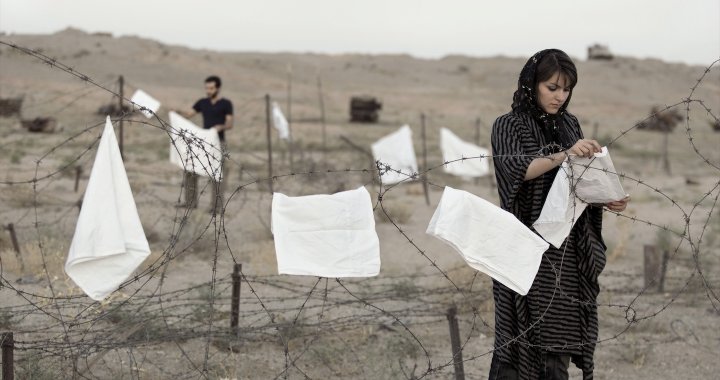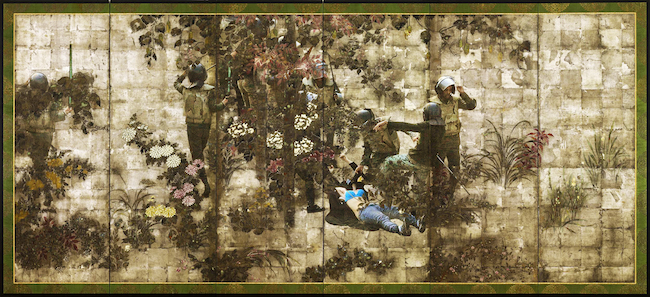
Regarding the pain of others
Kristian Vistrup Madsen
13/03/2017
“We shout and shout, but no one listens: Art from conflict zones”
CAMP / Center for Art on Migration Politics, Copenhagen
Through June 17, 2017
Exhibiting artist: Alfredo Jaar, Amel Ibrahimovic, Khaled Barakeh, Gohar Dashti, Nermine Hammam, Sandra Johnston
We Shout and Shout but No One Listens, art historian Nicholas Mirzoeff writes on the wall of the exhibition, ‘is about the relationship of the visible and the invisible. It is not an abstract idea but a lived reality.’ By its title we might also say that it is about the audible and the inaudible, and with reference to the accompanying text written by the philosopher Judith Butler for the catalogue, the grievable and the un-grievable; that is, who is generally recognisable as human, as a life worthy of grief, in the first place, and who is not. In this exhibition curated by CAMP (Centre for Art on Migration Politics) at the Trampoline House, a community centre for refugees in Copenhagen, six international artists, each with a personal experience of migration and conflict, explore representations of war and critique their inefficacy in producing appropriate and sustained responses.
When it comes to humanitarian crises, it is standard to assume that more images equal more awareness. However, this exhibition responds to a continuous global crisis in which bodies already not equally sharing in the distribution of grievability determined by whiteness, passports and GDP’s, are alienated further from compassion by the overexposure and subsequent dilution of images of violence and death. The works in this exhibition form an argument against indexical representation, as they consider alternative ways conveying the human sacrifices of armed conflicts by obscuring photographs through addition or detraction – or by moving away from photographs entirely.
.jpg)
Alfredo Jaar. Still from The Eyes of Gutete Emerita, 1996
.jpg)
Alfredo Jaar. Still from The Eyes of Gutete Emerita, 1996
Remarkable in its simplicity, ’In the Eyes of Gutete Emerita’ (1996), a darkroom installation by the Chilean artist Alfredo Jaar, presents us with just four slides. The first explains the killing during the 1994 Rwandan genocide of Gutete Emerita’s husband and two children, the second the circumstances of her narrow escape. Then, more white letters on black: ‘I remember her eyes / The eyes of Gutete Emerita’, before this pair of eyes fills the frame for a single second. While Gutete’s husband and children were murdered ‘before her eyes’, as the slide says, the Rwandan genocide was one towards which the international community ‘closed their eyes’. Highly aware of the difference between simply being exposed to images of tragedy, and what it would have meant to truly open one’s eyes to the conflict, the work denies us images of the bodies.
.jpg)
Khaled Barakeh. The Untitled Images, 2014
.jpg)
Khaled Barakeh. The Untitled Images, 2014
The Syrian-born artist Khaled Barakeh employs a similar tactic in ‘The Untitled Images’ (2014), a series of photographs of adults carrying their dead children taken by press photographers. In each photograph Barakeh has carefully removed the figure of the child with a scalpel, leaving the underlying white paper like a wound in the picture. A sculpture by the same artist, ’Regarding the Pain of Others’ (2013) is a deconstructed na’ash – a wooden stretcher that carried 135 dead bodies during the Syrian conflict before Barekeh had it smuggled out of the country. This is to say: let’s look at the infrastructure of war; let’s pick it apart and examine it. Rather than produce an affective response to the loss of lives, we are asked to recognise the material reality of the na’ash. Now partly reassembled into a chair, the spectre of the body remains on the traumatised wooden surface, but the body now implied is a living one; a body sitting up-right.

Amel Ibrahimovic. My Refugee Shoes and My Refugee Clothes, 1998
What we might take from this is that a body not represented is one that is allowed to continue to live – and not just as a victim of war, or a refugee, but one just as nuanced and changeable as all others. ‘My Refugee Shoes and My Refugee Clothes’, a bomber jacket and some dusty loafers sitting in the corner of the room, are what the artist Amel Ibrahimovic wore as he fled from Bosnia as a teenager in 1992. By turning his personal belongings into art, Ibrahimovic at once confronts the audience with the material mundanity of fleeing from war – I too had a jacket like that – and sheds his own refugee-skin, allowing his subjectivity to extend beyond that experience.

Nermine Hammam. Codes of My Kin from the series Unfolding, 2012

Nermine Hammam. Hibiscus, from the series Unfolding, 2012
Where Ibrahimovic politicises his personal items through historical context, the Egyptian artist Nermine Hamman personalises the uniformed faces of power. When soldiers arrived at Cairo’s Tahrir square at the end of the January revolution of 2011, Hamman witnessed them, wide-eyed with tiny frames, squinting as they climbed out of their vehicles. In four works from the ‘Uphekka’ series (2011), portraits of soldiers photographed unwittingly and apart from the group are collaged onto the Technicolor idyll of vintage postcard backgrounds of mountains and pagoda covered terraces.

Nermine Hammam. Upekkha, 2011
Here, Hamman deconstructs military displays of power and the accompanying brand of authoritative masculinity, allowing us to see frailty, desire and naivety; to see that the man inside the tank, really, is just a boy.

Sandra Johnston. Documentation of the performance To the Day, 2-part performance commissioned by CAMP, 2017
A striking colour-composition of red tables, sheer glasses and the yellow of a candle’s flame and a lump of butter became the stage for an incredibly tense performance by the Northern Irish artist Sandra Johnston during exhibition’s opening weekend. Here, water spills over the red table, as Johnston holds a burning candle between her feet, balancing one table upon another on four glasses, the precarious structure hung by a thread. She shows us no horror, and offers no clickbait. Her movements are slow and dignified as the meticulous operation plays out to the precise time of the burning candle. Yet what comes across is the immense and simultaneous fragility and strength of humans, and the prickling awareness in the audience of what it means to bear witness to struggle.
CAMP
Trampoline House, Thoravej 7, Copenhagen
www.campcph.org